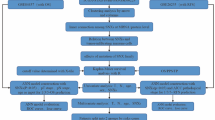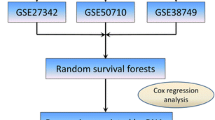Abstract
Gastric cancer (GC) is a progressive disease with high morbidity and mortality. Accumulating evidence indicated that nervous system-cancer crosstalk can affect the occurrence and progression of GC. However, the role of nerve-related lncRNAs (NRLs) in GC remains largely unexplored. In this study, a total of 441 nerve-related genes were collected from the KEGG database, and two approaches, unsupervised clustering and WGCNA, were employed to identify NRLs. Lasso regression analysis was then used to construct the nerve-related lncRNA signature (NRLS). Based on the expression profiles of 5 lncRNAs, we developed a stable NRLS to predict survival in GC patients, and survival analyses showed significantly shorter overall survival (OS) in patients with high NRLS. In addition, the NRLS was found to be positively correlated with immune characteristics, including tumor-infiltrating immune cells, immune modulators, cytokines and chemokines. We then analyzed the role of NRLS in predicting chemotherapy and immunotherapy responses, and constructed the OS nomogram combining NRLS and other clinical features. In conclusion, we constructed a robust NRLS model to stratify GC patients and predict the outcomes of chemotherapy and immunotherapy. This study can provide a new perspective for future individualized treatment of GC.










Similar content being viewed by others
Data Availability
The public data and corresponding clinical information can be found in the TCGA (https://portal.gdc.cancer.gov/), UCSC Xena (https://xenabrowser.net/), and GEO (https://www.ncbi.nlm.nih.gov/geo/) database. The nerve-related genes are available at the KEGG database (https://www.kegg.jp/).
References
Machlowska, J., et al. (2020). Gastric cancer: Epidemiology, risk factors, classification, genomic characteristics and treatment strategies. International Journal of Molecular Sciences, 21(11), 223–230.
Thrift, A. P., & El-Serag, H. B. (2020). Burden of gastric cancer. Clinical Gastroenterology and Hepatology, 18(3), 534–542.
Smyth, E. C., et al. (2020). Gastric cancer. Lancet, 396(10251), 635–648.
Sung, H., et al. (2021). Global cancer statistics 2020: GLOBOCAN estimates of incidence and mortality worldwide for 36 cancers in 185 countries. CA: A Cancer Journal for Clinicians, 71(3), 209–249.
Waldum, H., & Fossmark, R. (2021). Gastritis, gastric polyps and gastric cancer. International Journal of Molecular Sciences, 22(12), 6548.
Patel, T. H., & Cecchini, M. (2020). Targeted therapies in advanced gastric cancer. Current Treatment Options in Oncology, 21(9), 70.
Li, K., et al. (2021). Advances in clinical immunotherapy for gastric cancer. Biochimica et Biophysica Acta, 1876(2), 188615.
Li, G. Z., et al. (2022). Surgical management of gastric cancer: A review. JAMA Surgery, 157(5), 446–454.
Sexton, R. E., et al. (2020). Gastric cancer: A comprehensive review of current and future treatment strategies. Cancer and Metastasis Reviews, 39(4), 1179–1203.
Mun, J. Y., et al. (2022). Dual relationship between stromal cells and immune cells in the tumor microenvironment. Frontiers in Immunology, 13, 864739.
Rojas, A., et al. (2020). Gastric tumor microenvironment. Advances in Experimental Medicine and Biology, 1226, 23–35.
Chen, D., et al. (2021). Metabolic regulatory crosstalk between tumor microenvironment and tumor-associated macrophages. Theranostics, 11(3), 1016–1030.
Xiao, Y., & Yu, D. (2021). Tumor microenvironment as a therapeutic target in cancer. Pharmacology & Therapeutics, 221, 107753.
Hutchings, C., et al. (2020). Nerve input to tumours: Pathophysiological consequences of a dynamic relationship. Biochimica et Biophysica Acta, 1874(2), 188411.
Keough, M. B., & Monje, M. (2022). Neural signaling in cancer. Annual Review of Neuroscience, 45, 199–221.
Zahalka, A. H., & Frenette, P. S. (2020). Nerves in cancer. Nature Reviews Cancer, 20(3), 143–157.
Wang, K., et al. (2020). Nervous system and gastric cancer. Biochimica et Biophysica Acta, 1873(1), 188313.
Cervantes-Villagrana, R. D., et al. (2020). Tumor-induced neurogenesis and immune evasion as targets of innovative anti-cancer therapies. Signal Transduction and Targeted Therapy, 5(1), 99.
Yu, K., et al. (2020). PIK3CA variants selectively initiate brain hyperactivity during gliomagenesis. Nature, 578(7793), 166–171.
Hayakawa, Y., et al. (2017). Nerve growth factor promotes gastric tumorigenesis through aberrant cholinergic signaling. Cancer Cell, 31(1), 21–34.
Magnon, C., et al. (2013). Autonomic nerve development contributes to prostate cancer progression. Science, 341(6142), 1236361.
Park, E. G., et al. (2022). Tumor immune microenvironment lncRNAs. Briefings in Bioinformatics, 23(1), 504.
Tan, Y. T., et al. (2021). LncRNA-mediated posttranslational modifications and reprogramming of energy metabolism in cancer. Cancer Communications (London), 41(2), 109–120.
Zhang, J., et al. (2019). ALKBH5 promotes invasion and metastasis of gastric cancer by decreasing methylation of the lncRNA NEAT1. Journal of Physiology and Biochemistry, 75(3), 379–389.
Luo, Y., et al. (2021). Long noncoding RNA (lncRNA) EIF3J-DT induces chemoresistance of gastric cancer via autophagy activation. Autophagy, 17(12), 4083–4101.
Zhang, F., et al. (2021). LncRNA CRNDE attenuates chemoresistance in gastric cancer via SRSF6-regulated alternative splicing of PICALM. Molecular Cancer, 20(1), 6.
Qin, X., et al. (2022). Long noncoding RNA TMEM147-AS1 serves as a microRNA-326 sponge to aggravate the malignancy of gastric cancer by upregulating SMAD5. Oncology Research, 29(4), 263–273.
Cai, T., et al. (2022). Long noncoding RNA BBOX1-AS1 promotes the progression of gastric cancer by regulating the miR-361-3p/Mucin 13 signaling axis. Bioengineered, 13(5), 13407–13421.
Huang, J., et al. (2022). Distinct tumor microenvironment landscapes in gastric cancer classified by cuproptosis-related lncRNAs. Journal of Cancer, 13(15), 3687–3700.
Chen, L., & Deng, J. (2022). Role of non-coding RNA in immune microenvironment and anticancer therapy of gastric cancer. Journal of Molecular Medicine (Berlin, Germany), 100(12), 1703–1719.
Li, C., et al. (2022). Role of an exosomes-related lncRNAs signature in tumor immune microenvironment of gastric cancer. Frontiers in Cell and Developmental Biology, 10, 873319.
Love, M. I., et al. (2014). Moderated estimation of fold change and dispersion for RNA-seq data with DESeq2. Genome Biology, 15(12), 550.
Gautier, L., et al. (2004). affy–analysis of Affymetrix GeneChip data at the probe level. Bioinformatics, 20(3), 307–315.
Wilkerson, M. D., & Hayes, D. N. (2010). ConsensusClusterPlus: A class discovery tool with confidence assessments and item tracking. Bioinformatics, 26(12), 1572–1573.
Langfelder, P., & Horvath, S. (2008). WGCNA: An R package for weighted correlation network analysis. BMC Bioinformatics, 9, 559.
Ritchie, M. E., et al. (2015). limma powers differential expression analyses for RNA-sequencing and microarray studies. Nucleic Acids Research, 43(7), e47.
Yu, G., et al. (2012). clusterProfiler: An R package for comparing biological themes among gene clusters. OMICS: A Journal of Integrative Biology, 16(5), 284–287.
Newman, A. M., et al. (2015). Robust enumeration of cell subsets from tissue expression profiles. Nature Methods, 12(5), 453–457.
Li, T., et al. (2017). TIMER: A web server for comprehensive analysis of tumor-infiltrating immune cells. Cancer Research, 77(21), e108–e110.
Becht, E., et al. (2016). Estimating the population abundance of tissue-infiltrating immune and stromal cell populations using gene expression. Genome Biology, 17(1), 218.
Racle, J., et al. (2017). Simultaneous enumeration of cancer and immune cell types from bulk tumor gene expression data. eLife, 6, e26476.
Hänzelmann, S., et al. (2013). GSVA: Gene set variation analysis for microarray and RNA-seq data. BMC Bioinformatics, 14, 7.
Yoshihara, K., et al. (2013). Inferring tumour purity and stromal and immune cell admixture from expression data. Nature Communications, 4, 2612.
Mayakonda, A., et al. (2018). Maftools: Efficient and comprehensive analysis of somatic variants in cancer. Genome Research, 28(11), 1747–1756.
Geeleher, P., et al. (2014). pRRophetic: An R package for prediction of clinical chemotherapeutic response from tumor gene expression levels. PLoS ONE, 9(9), e107468.
Jiang, P., et al. (2018). Signatures of T cell dysfunction and exclusion predict cancer immunotherapy response. Nature Medicine, 24(10), 1550–1558.
Hoshida, Y., et al. (2007). Subclass mapping: Identifying common subtypes in independent disease data sets. PLoS ONE, 2(11), e1195.
Iasonos, A., et al. (2008). How to build and interpret a nomogram for cancer prognosis. Journal of Clinical Oncology, 26(8), 1364–1370.
Zeng, Y., & Jin, R. U. (2022). Molecular pathogenesis, targeted therapies, and future perspectives for gastric cancer. Seminars in Cancer Biology, 86(Pt 3), 566–582.
Eusebi, L. H., et al. (2020). Gastric cancer prevention strategies: A global perspective. Journal of Gastroenterology and Hepatology, 35(9), 1495–1502.
Sukri, A., et al. (2020). Epidemiology and role of Helicobacter pylori virulence factors in gastric cancer carcinogenesis. APMIS, 128(2), 150–161.
Biagioni, A., et al. (2019). Update on gastric cancer treatments and gene therapies. Cancer and Metastasis Reviews, 38(3), 537–548.
Zhao, Q., et al. (2019). Immunotherapy for gastric cancer: Dilemmas and prospect. Briefings in Functional Genomics, 18(2), 107–112.
Erin, N., et al. (2022). Regulation of carcinogenesis by sensory neurons and neuromediators. Cancers (Basel), 14(9), 2333.
Kamiya, A., et al. (2021). Sympathetic and parasympathetic innervation in cancer: Therapeutic implications. Clinical Autonomic Research, 31(2), 165–178.
Fan, Z., et al. (2022). Identification of the three subtypes and the prognostic characteristics of stomach adenocarcinoma: Analysis of the hypoxia-related long non-coding RNAs. Functional & Integrative Genomics, 22(5), 919–936.
Wu, H., et al. (2021). Survival-related lncRNA landscape analysis identifies LINC01614 as an oncogenic lncRNA in gastric cancer. Frontiers in Genetics, 12, 698947.
Jiang, S. H., et al. (2019). GABRP regulates chemokine signalling, macrophage recruitment and tumour progression in pancreatic cancer through tuning KCNN4-mediated Ca(2+) signalling in a GABA-independent manner. Gut, 68(11), 1994–2006.
Jurcak, N. R., et al. (2019). Axon guidance molecules promote perineural invasion and metastasis of orthotopic pancreatic tumors in mice. Gastroenterology, 157(3), 838-850.e6.
Chavan, S. S., et al. (2017). Mechanisms and therapeutic relevance of neuro-immune communication. Immunity, 46(6), 927–942.
Yang, S., et al. (2022). Identification of enhancer RNA CDK6-AS1 as a potential novel prognostic biomarker in gastric cancer. Frontiers in Genetics, 13, 854211.
Zeng, D., et al. (2021). Tumor microenvironment evaluation promotes precise checkpoint immunotherapy of advanced gastric cancer. Journal for Immunotherapy of Cancer, 9, 8.
Funding
The authors received no financial support for the research, authorship and publication for this article.
Author information
Authors and Affiliations
Contributions
LQ and SJ participated in study design and drafted the manuscript. LQ and YL performed the data curation and analysis. ZY and XZ contributed to visualization. YG contributed for overall editing and supervision. All authors reviewed the manuscript.
Corresponding authors
Ethics declarations
Conflict of interest
The authors declare that they have no conflict of interest.
Ethical Approval
Not applicable.
Additional information
Publisher's Note
Springer Nature remains neutral with regard to jurisdictional claims in published maps and institutional affiliations.
Supplementary Information
Below is the link to the electronic supplementary material.
Rights and permissions
Springer Nature or its licensor (e.g. a society or other partner) holds exclusive rights to this article under a publishing agreement with the author(s) or other rightsholder(s); author self-archiving of the accepted manuscript version of this article is solely governed by the terms of such publishing agreement and applicable law.
About this article
Cite this article
Qiu, L., Liu, Y., Yang, Z. et al. Clinical Significance and Immune Infiltration Analyses of a Novel Nerve-Related lncRNA Signature in Gastric Cancer. Mol Biotechnol (2023). https://doi.org/10.1007/s12033-023-00997-4
Received:
Accepted:
Published:
DOI: https://doi.org/10.1007/s12033-023-00997-4




